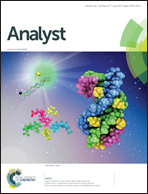A highly sensitive fluorescence assay for methyltransferase activity by exonuclease-aided signal amplification†
Abstract
DNA methylation, catalyzed by methyltransferases, plays critical roles in various biological processes in both prokaryotes and eukaryotes. Bacterial DNA adenine methyltransferases (DAM) are associated with bacterial pathogenesis and essential for bacterial virulence and viability. Since mammals do not methylate DNA at adenine, bacterial DAM is considered to be a great candidate target for developing new therapeutics for diseases. In the current study, we developed a simple, rapid and highly sensitive fluorescence method for the detection of DAM based on exonuclease-aided signal amplification. In the proposed strategy, a liberated amplifier upon DAM methylation and Dpn I digestion of the substrate can hybridize with a reporter (FT) that contains a quencher (TAMRA) at the second base of the 3′ end and a fluorophore (FAM) at the fifth base. Upon hybridization, exonuclease III degrades the reporter in the formed duplex DNA from the 3′ end successively, releasing the fluorophore from the quencher and resulting in an intensive appearance of the fluorescent signal. The amplifier will hybridize with another reporter and enter a new cycle, which therefore can amplify the signal and dramatically increase the detection sensitivity even with an extremely low amount of amplifier. Using this strategy, the detection limit down to 0.0025 U mL−1 of DAM was achieved within a short assay time of 30 min. Furthermore, the assay was applied to evaluate endogenous DAM activity in E. coli cell at different growth stages as well as the effects of inhibitors on DAM activity. Given the attractive analytical performance, the sensing strategy may find many important applications in biomedical research and clinical diagnosis.


 Please wait while we load your content...
Please wait while we load your content...